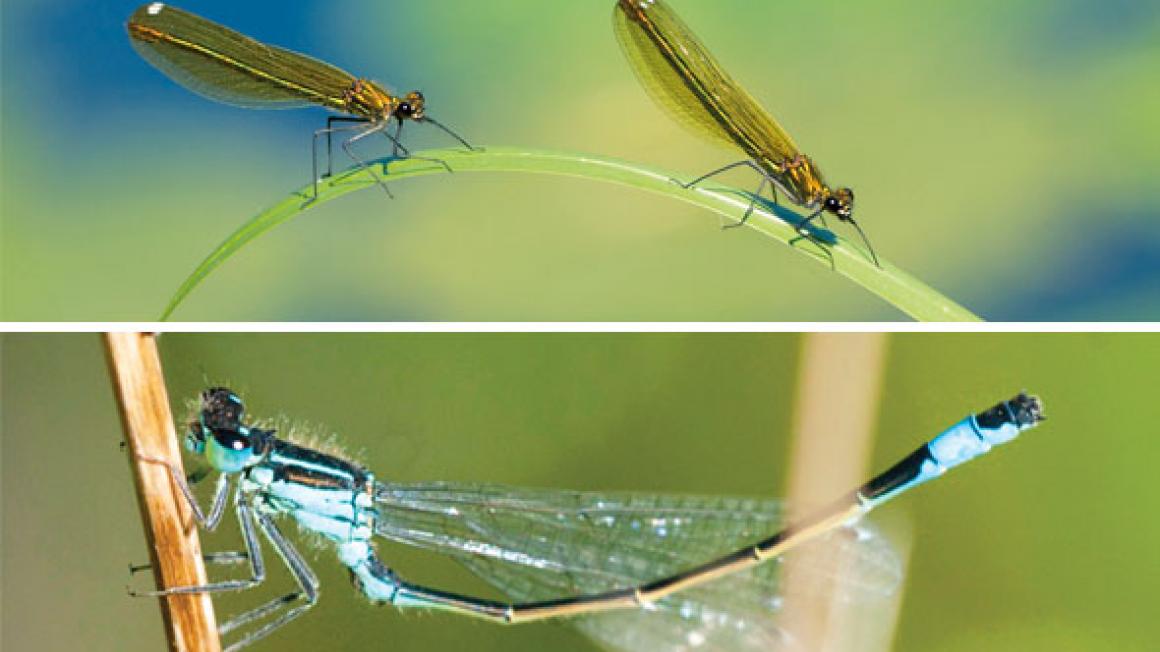Adventures with DRAGONS & DAMSELS
Wildlife has had a grip on my imagination since I was a little girl. When I was 11, my parents bought a house over a shop in Hastings High Street. After some 21 years of librarianship, my father started up a second-hand bookshop, and I often borrowed books from its shelves to read. It wasn’t the children’s fiction I was after but the nature books – brightly illustrated modern fi eld guides, Gerald Durrell’s memoirs, and fat, indepth 1950s monographs on individual species.
Having all this to hand made up for the fact that I didn’t get to spend much time actually out in nature, but that changed with adulthood. My primary interest was birdwatching. On the May morning when I saw the strange creature that stopped me in my tracks, I’d been birding my local patch, noting singing yellowhammers and hunting sparrowhawks. The mysterious dark-winged creature wasn’t a bird though, it was an insect – I could at least be sure of that much. When I finally found it again, resting on a leaf, I could see what kind of insect it was – a damselfly.
I thought I knew damselflies. They were stick-shaped, sky blue little insects with skinny see-through wings and a dumb-bell-shaped head. In flight they looked wingless, like needles bobbing inexplicably along. The damselfly I was looking at now, though, was twice the size of the little blue jobs, with wings not invisible but full, broad and deeply coloured. Its body was different too, still long and slim but glistening violet. From another angle it changed to bright shining green. This iridescent colour put every bird I’d ever seen to shame. That was my fi rst encounter with a ‘beautiful demoiselle’ damselfly, Calopteryx virgo, as I later discovered. Its beauty, as the song goes, overthrew me. Yet it wasn’t until the summer of 2010, when I first began to take wildlife photographs, that damselflies and dragonflies really caught my attention again. To photograph a dragonfly in its breakneck flight became an obsession. Through a macro lens, the delicate, alien detail of a damselfly’s body was revealed.
Dragonflies and damselflies together make up the taxonomic order Odonata. The word Odonata comes from the Greek ‘odontos’ or ‘tooth’, describing their barbed, cutting mouthparts: the equipment of a predator. Dragonflies are the wolves, the falcons, the sharks of the insect world, the high-speed hunters. Streamlined and sturdy on two pairs of steel-strong wings, they rattle as they race past, tearing up the air and chasing down smaller flying insects.

Their wraparound eyes miss nothing, their hooked legs are always poised to seize. Damselflies are slighter, built more like a Bristol Boxkite than a fighter jet. They flutter rather than zoom, but are as predatory as their big cousins – though often the dragons hunt the damsels.
In Britain we have fewer than 50 breeding Odonata species. Many of these are common, living almost anywhere there is fresh water (in which they lay their eggs and their larvae develop). But I’d need to go to Broadland for the Norfolk hawker, the New Forest to find a southern damselfly, the Thames valley to meet a common clubtail and a Highland peat bog for the azure hawker. I began to hatch a plan – I would make 2011 my year of dragon-hunting, and I’d write a book about it.
In the event, the first dragonfly I went to see in April 2011 was not one of our breeding species, but an invader, a vagrant emperor, a species noted for its wandering ways. This 6cm insect had flown to Britain from Africa, and was now having a fine time pursuing prey along the reedy ditches of the Dungeness peninsula. It had drawn an admiring crowd – I discovered that many of the ‘twitchers’ who chase rare birds also chase rare dragons.
Over the next two summers (because I found I couldn’t stop after just one) I spent hours in the company of dragons and damsels. In the west Highlands I watched an empty expanse of moorland come alive with dragonflies moments after the sun. In Norfolk I made eye contact with a four-spotted chaser, which slammed on its brakes mid-air to scrutinise me before continuing its territorial patrol. I’ve rescued damselflies from cobwebs and held them while they meticulously removed every trace of sticky silk from their bodies before flying away. I’ve watched their courtship, culminating with the pair contorting their bodies, joined at two points, into a heart shape. I was astonished to see damselflies dive at a huge emperor dragonfly, apparently trying to drive it away – complex behaviour far beyond anything I’d expected from an insect.
Dragons and damsels are not for everyone. Some of my friends are scared stiff of big dragonflies. Others find them pretty, but only from a distance. But for me, they are enchanting in all their detail and complexity, their strangeness and savagery. The book may be written now, but the fascination is there for life.
Dragonflight: In Search Of Britain’s Dragonflies And Damselflies, by Marianne Taylor, is published by Bloomsbury, priced £16.99.


